![]()
A Jewish Wedding Ceremony
![]()
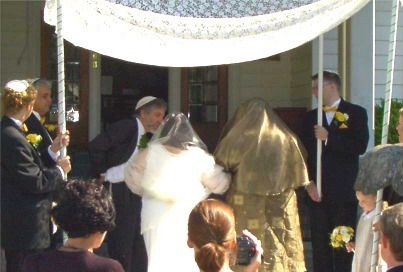
A lesbian Jewish Wedding ceremony
In traditional Jewish literature marriage is actually called kiddushin, which translates as “sanctification” or “dedication.” “Sanctification” indicates that what is happening is not just a social arrangement or contractual agreement, but a spiritual bonding and the fulfillment of a mitzvah, a Divine precept. “Dedication” indicates that the couple now have an exclusive relationship, that involves total dedication of the bride and groom to each other, to the extent of them becoming “one soul in two bodies.”
Shidduch
· The first stage of a traditional Jewish marriage, shidduch means “matchmaking.”
· The process of finding a mate is not random or based purely on external aspects. A close friend or relative pair up a prospective bride and groom and arrange for them to meet to see if they are compatible.
· The first meeting of the couple is focused on discussing issues that are important to marriage. The Talmud states that the couple must also be physically attracted to each other, and this is also determined in the first meeting. However, Jewish law dictates that no physical contact is allowed between a man and woman until they are married; they also are not allowed to be alone together in a closed room or secluded area.
Vort
· Once the families of the couple have met and become acquainted, and the young couple have decided to marry, the families usually announce the occasion with a small reception known as a vort.
· At the vort, some families sign a contract that outlines the obligations of each side regarding the wedding and a final date for the wedding. Other families do this at the wedding reception an hour or so before the marriage.
· One week before the wedding, the groom (chosson or chatan) and bride (kallah) stop seeing each other, in order to enhance the joy of their wedding through their separation.
Ketuvah
· At the wedding reception, which takes place before the wedding itself, the first thing usually done is the signing and witnessing of the ketuvah, or marriage contract. This contract is ordained by Mishnaic law (circa 170 CE) and, according to some, dates back to Biblical times.
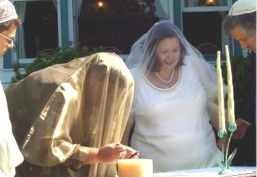
· The ketuvah, written in Aramaic, details the husband’s obligations to his wife: food, clothing, dwelling, and pleasure. It also states that should the couple divorce, the husband is to pay his wife a sum of money to support her.
· The document is signed by the groom and witnessed by two people. It has the standing of a legally binding agreement, that in many countries is enforceable by secular law.
· The signing of the document is often followed by some light snacks and hard liquor for the traditional lechaims (Jewish salute that means “to life”).
Bedekin
· After the ketuvah, the groom does the bedekin, or “veiling.” The groom, along with his father and future father-in-law, is accompanied by musicians and the male guests to the room where the bride is, sitting in a throne like chair, receiving her guests.
· The groom, who has not seen her for a week, covers his bride-to-be’s face with a veil This ceremony is mainly for the legal purpose of the groom identifying the bride before the wedding.
Chuppah or Huppa
· The next stage of the wedding ceremony is the chuppah, or “canopy.” Under the chuppah is a table with two glasses and a bottle of kiddush wine.
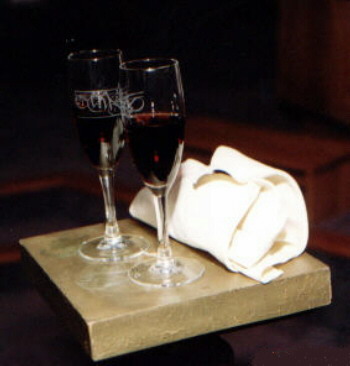
· The chuppah is a decorated piece of cloth held aloft on four poles. It is sometimes made of velvet, satin but oftentimes a large talis (traditional prayer cloth) is used. It is a symbolic home for the new couple. It is usually held outside, under the start, as a sign of the blessing given by God to Abraham, that his children would be “as the stars of the heavens.”
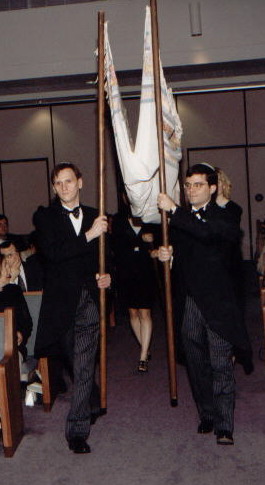

· The groom is accompanied to the chuppah by his parents, and usually wears a white robe (known as a kittel) to indicate that the bride and groom are starting a new life together, with a clean white slate, since they are uniting to become a new entity, without past sins.
· The bride and groom usually fast on the day of the wedding (until the chuppah) since for them it is like a personal Yom Kippur, the Day of Atonement.
· While the bride comes to the canopy with her parents, a cantor sings a selection from the Song of Songs, and the groom prays that his unmarried friends find their true partners in life. When the bride arrives at the chuppah, she circles the groom seven times with her mother and future mother-in-law, while the groom continues to pray. This symbolizes the idea of the woman being a protective, surrounding light of the household, that illuminates it with understanding and love from within and protects it from harm from without. The number seven parallels the seven days of creation, and symbolizes the fact that the bride and groom are about to create their own “new world” together. When the bride finishes her circling she takes her place at the right side of her groom.

· Today, some couples find the ritual objectionable, seeing it as symbolic of the bride’s subservience. A moderation of this ritual is that the couple circle one another – 3x each and then one together.
· Under the chuppah, a Rabbi or family member recites a blessing over wine, a blessing that praises and thanks God for giving laws of sanctity and morality to preserve the sanctity of family life and of the Jewish people. The couple then drink from the wine. The blessings are recited over wine, since wine is symbolic of life. The full cup of wine also symbolizes the overflowing of Divine blessing.
Sheva Brachos
· At this point the sheva brachos, or seven blessings, are recited either by one Rabbi or by various people the families want to honor. The seven blessings are roughly translated as:
1. Blessed are You, Hashem, our God, Ruler of the universe, Who created everything for His glory.
2. Blessed are You, Hashem, our God, Ruler of the universe, Who fashioned humanity.
3. Blessed are You, Hashem, our God, Ruler of the universe, Who fashioned humanity in His image, in the image of his likeness, and prepared from Himself a building for eternity. Blessed are You Hashem, Who fashioned humanity.
4. Bring intense joy and exultation to the barren one through the ingathering of her children amidst her in gladness. Blessed are You, Hashem, Who gladdens Zion through her children.
5. Gladden the beloved companions as You gladdened Your creature in the Garden of Eden from aforetime. Blessed are You, Hashem Who gladdens groom and bride.
6. Blessed are You, Hashem, our God, Ruler of the universe, Who created joy and gladness, groom and bride, mirth (mirth?), glad song, pleasure, delight, love, brotherhood, peace, and companionship. Hashem, our God, let there soon be heard in the cities of Judah and the streets of Jerusalem the sound of joy and the sound of gladness, the voice of the groom an the voice of the bride, the sound of the groom's jubilance from their canopies and of youths from their song-filled feasts. Blessed are You, Who gladdens the groom with the bride.
7. Blessed are You Hashem, our God, Ruler of the Universe, Who created the fruit of the vine.
· The blessings are recited over a full cup of wine, which the couple also shares in drinking, and then the groom breaks the glass by stamping on it. This custom dates back to Talmudic times, and symbolizes the idea of keeping Jerusalem and Israel in the minds of the Jewish people even at times of joy. Just as the Temple in Jerusalem was destroyed in 70 CE by the Romans, the Jewish people break a utensil to show their identification with the sorrow of Jewish exile.

· With the breaking of the glass the band plays and the guests usually break out into dancing and cries of “Mazaltov! Mazaltov!”
Cheder Yichud
· Once the couple is married, they are accompanied by dancing guests to the cheder yichud, “the room of privacy.” They may now be alone in a closed room together, an intimacy reserved only for a married couple. In fact, according to many Jewish legal authorities, the very fact that they are alone together in a locked room, is a requirement of the legal act of marriage, and hence their entry into the room must be observed by the two witnesses of the marriage.
· While the bride and groom are alone together (usually eating, after having fasted all day), the guests sit down to eat a festive meal. The meal is preceded by ritual washing of the hands, and the blessing over bread.
· At some point, the band announces the arrival of the newly married couple and everyone joins in dancing around the bride and groom. The dancing, in accordance with Jewish law requires a separation between men and women for reasons of modesty, and hence there is a mechitzah, or partition between the men and women.
· During the dancing, the bride and groom are symbolically made king and queen of the dance. They are put in their "thrones" and hoisted up while everyone dances around them.
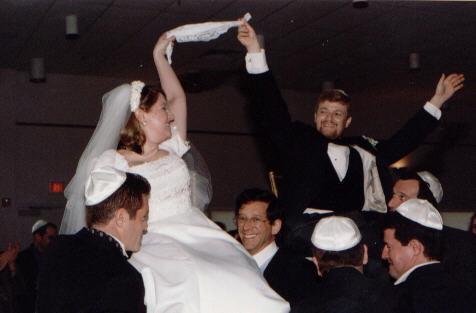
· The meal ends with the Birchas Hamazon, “Grace After Meals,” and again the seven blessings are recited over wine, shared afterwards by the bride and groom.
Sources